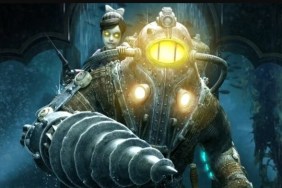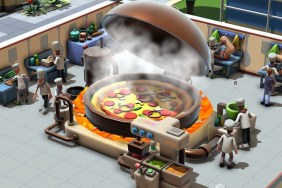Sega knocks it out of the Reich.
There’s an old Bloom County comic strip where the Usual Anthropomorphized Suspects are watching some military combat on television—it’s either live cable coverage of some real-world, body-count conflict or an old episode of “Rat Patrol”, they’re not really sure—and in a fit of moral confusion, one of them suddenly yells something along the lines of “Would somebody please tell me if I should be enjoying this or NOT?!” Sega’s deceptively beautiful Valkyria Chronicles offers up some moments like that. There you are, enjoying this visually gorgeous and quite entertaining game… and then some choice bit of the story will suddenly rear up and remind you of the brutal war that inspired the whole eye-pleasing, cel-shaded, cosplay-clad, pastels-in-motion story in the first place.
[image1]Under all that unthreatening, anime-tinged war paint, Valkyria Chronicles has some exquisitely tense moments, tough tactical calls, confounding minor flaws… and some nasty nods to history that you could even call ‘sobering’ if the overall product weren’t so damned pretty.
The year is 1935, and in the opening gambits of the ‘Second Europan War’, the vast military machine of the East Europan Imperial Alliance has blitzed westward with its surprise invasion of Gallia—a small Atlantic Federation border nation, seemingly composed largely of local-yokel townsfolk hurriedly trading in their rustic bakery aprons and farmland hoes for stylish pseudo-militia garb and unfamiliar slug-throwing military hardware. Long before the first not-so-veiled references to the pogroms of Europe (and the alarmist specter of The Military Superpower Preying on Sovereign Nations for their Resources crapola) turn up, you’ll start to sense that this whole thoroughly presented world is at once disconnectedly wrong and eerily familiar. If you listen closely, you can hear Harry Turtledove getting a little splinter-universe chubby in his sleep.
Valkyria Chronicles is a hybrid turn-based/action-point-based strategy game bookended—literally, in this case—by straightforward, beautifully rendered animated cinematics. The progression of the story is presented as chapters in a virtual book on the history of the Second Europan War, with you turning pages, chapters, bookmarks, illustrations, and all. It largely tells the tale centered around Squad 7, a military unit cobbled together from soldiers both experienced and inexperienced. The core members drive the story, but even the troops added to (or killed off of) the squad each have their own stats, personality quirks, and interrelations with one another. What results is an ultimately linear game that nevertheless lets players employ their own personal style on the battlefield.
The heart of the game is a turn-based battle scheme rather clumsily named “BLiTZ” (which stands for “Battle of Live Tactical Zones”… yeah, I know about the ‘i’… onward!) that makes for a surprisingly engaging, reliably tense combat system. Each turn, you can spend a certain number of your pooled, accumulated “Command Points” (which are based in part on how many command-level soldiers you have in your current squad roster) to order individual combatants.
[image2]Once you’ve decided to order, say, a shocktrooper (the front-line, general-purpose, particularly badass backbone soldier-type available to your squad) the viewpoint shifts from a faded, overhead battle-map and zooms down to ground level in a follow-cam view. As you move said trooper in traditional third-person shooter (left-stick move/right-stick look) fashion, an Action meter at the bottom of the screen continually drains with each step the trooper takes. Retro gamers can think of it as the onscreen equivalent of Action Points in a creaker tabletop game like Snapshot.
At any point during the turn, your selected unit can elect to take a single special action—firing his/her primary weapon, lobbing a grenade, healing/repairing nearby friendlies with the magic-resource known as Ragnite, etc. Time is more or less suspended during these actions, allowing players to fine-tune critical shots or grenade throws at their leisure.
If the action meter is still partially filled even after such special action, the character can continue to move. Indeed, the constant, ideal rhythm is to move into effective range, shoot something or someone up, and then retreat to a safe crouch – preferably near some sandbags, behind a friendly tank, or in some high, concealing grass before the Action meter depletes entirely. Catching opportunity-fire when you cross the enemy’s field of fire (during your turn) is bad enough, so leaving yourself out in the open to catch the brunt of their fury during their turn is much worse and often fatal.
You command a number of soldiers in a variety of classes. In addition to the aforementioned shocktrooper, you’ll also have lightly-armed scouts, whose high mobility is a godsend when you’re first scoping out the battlefield or rushing last-minute medical aid to your fallen soldiers; snipers, who can climb certain towers in the game for a commanding view of the battlefield (at least until said perch gets directly attacked); engineers, who can disable mines and repair tanks—a game-savingly vital function in many battles; and tank-killing Lancers, who can also fell ruins in one crucial battle against a ludicrously oversized, monster battle-machine. Welkin, your squad leader and tank commander, controls an old but serviceable tank—and oh, dear God, it’s actually called the “Edelweiss”—but its armored awesomeness will cost you two Command Points per order.
[image3]Despite the supposedly ‘relaxed’ nature of turn-based games as opposed to true real-time ones, Valkyria Chronicles gets downright, nail-gnawingly tense. Even while you’re scrambling across hostile territory during what is supposed to be ‘your’ turn, enemies who are situated in such a way as to take an opportunistic shot at you will do so. There is nothing quite so dishearteningly nerve-wracking as charging across a live battlefield, pushing your chosen character to his/her utmost Action Point limit, taking hostile fire from unknown quarters, hoping to bring some much-needed, last-minute medical help, ammo, or geek-squad repair skills to a friendly in need… only to be unceremoniously capped at the last nanosecond. I’ve actually had people watching next to me claw their hands into the sofa and bellow in frustration at moments like these, as though they themselves had just taken that lethal, last-second bullet to the head during a critical, attempted rescue operation.
Part of it is the personalized nature of your squad—after a few basic intro missions, you’ll be hand-picking and equipping your own squad members, each with his/her own unique personality traits and affinities that actually have a tangible effect on the game. For example, the ‘chatty Cathy’ soldier freaks out if left temporarily isolated on the battlefield, the man-hating, butch female fighter takes a performance hit if surrounded by sausages in uniform (or the overtly-fey lisper who responds to orders with lines like “I’ll handle it, hon”), the tank-killing bag of macho who has a debilitating allergy to the desert, and so forth. Soldiers also have individual likings/dislikings for other particular soldiers, which makes for some advantageous pairing—if you’re up for that sort of thing.
It’s all bundled up in a brilliant, appealing storytelling package. It wouldn’t do to give away any specific plot-spoilers, of course, but the anime-esque story sequences that drive the game between playable battles are mostly well-written and voiced (English or Japanese). Again, I’ve had those same, aforementioned couch-sitters cheering me on to victory in various battles just so they could watch the next animated chapter. While much of the story is by-the-numbers (albeit well-done and entertaining) upbeat anime-styled fluff, there are some truly emotional, funny, beautiful—and even startling—moments.
Outside the turn-based fighting proper, you can take your experience on the battlefield and exchange it for weapon upgrades and character-class training between missions, or simply check out the in-game encyclopedic references that serve to background and flesh out the intriguing, muddled-reflections-of-our-reality game world. All in all, it’s a cool, elegant package. And hey—when you do manage to start killing off your squad members (and they can die, like, for good), you can pay tribute to the fallen in the war memorial cemetery—nice bleak touch!
[image4]You have to figure that a product that can soar so high one moment can occasionally auger deeply into the ground the next, and the mostly brilliant Valkyria Chronicles does have its share of WTF moments. Key among these are the expected A.I. flip-outs, wherein your nominally-formidable enemy will occasionally do something so unwarranted and ultra-retarded that it almost makes you wonder if they’re up to something especially devious—tanks using up precious Command Points to do a lot of nothing, calls for reinforcements not suited to the forces they already know you have deployed, that kind of thing.
More disappointing are the instances of mechanical-inconsistency-bordering-on-cheapness that plagues the game. A tank’s mortar blast can be used to damage and, as you can imagine, violently scatter packs of enemies—and yet, if you cunningly land a mortar on an enemy and send him flying over a precipice, he will re-appear right where he was before. Not cool. Also, the game’s combat scheme seems to take the notion of being ‘behind cover’ –and what constitutes an effective headshot at certain ranges—extremely loosely.
But these hiccupy flaws stand in stark contrast to the rest of the game’s general excellence. Even beginners will quickly learn and compensate for these minor, cropping weirdnesses, and others still will not happen to encounter (or at least notice) them. The vast-majority rest of the time, Valkyria Chronicles offers a unique take on RPG-strategy, a truly involving story, endearing characters, and a chance to reflect upon—or wonderfully, hopelessly anachronize— whatever sense of real-world history you may still have in your head.
-
Absolutely elegant, gorgeous presentation
-
Unique approach to RPG strategy
-
Fleshed-out, mangled-mythos if-world
-
Engaging story
-
Mostly good voicework
-
Hit-and-miss AI
-
Some annoyingly inconsistent mechanics







